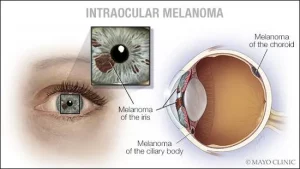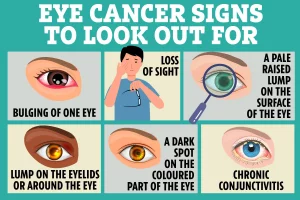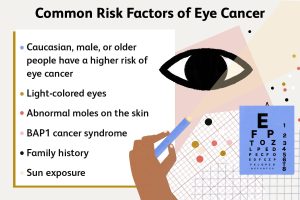Introduction
Eye cancer, a spectrum of rare malignancies originating within the eye, presents a complex landscape encompassing the eyeball and its surrounding structures. Delving into the various types, symptoms, diagnosis methods, risk factors, and treatment modalities offers a comprehensive understanding of this intricate medical condition.

Types of Eye Cancer
Intraocular Melanomas
Intraocular melanomas, the most prevalent eye cancers, arise from melanocytes. This category includes:
- Iris Melanoma: Forming in the colored part of the eye (iris), often characterized by a dark, slow-growing spot.
- Ciliary Body Melanoma: Originating in the muscles that adjust the eyeball lens.
- Choroidal Melanoma: Developing in the layer nourishing the retina and the front of the eye, with the choroid being the primary site.

Eyelid and Orbital Cancer
Orbital and adnexal cancer form near the eyeball, with notable types being:
- Squamous Cell Carcinoma: Emerging from squamous cells in the top skin layer.
- Basal Cell Carcinoma: Originating from basal cells in the top skin layer.
- Rhabdomyosarcoma: Developing inside muscle tissue.

Retinoblastoma
Primarily affecting children under the age of five, retinoblastoma is a malignant tumor originating from the retina.

Intraocular Lymphoma
This rare B-cell lymphoma forms in white blood cells (lymphocytes) and is more prevalent in individuals over 50 or those with weakened immune systems.

How Common is Eye Cancer?
Despite its rarity, eye cancer impacts around 3,400 individuals annually in the United States. Notably, intraocular melanomas, affecting approximately 2,500 people yearly, dominate the landscape.

Symptoms and Causes
Symptoms of Eye Cancer
Distinctive symptoms may indicate the presence of eye cancer. These include:
- Painless Vision Loss: A common symptom.
- Blurry Vision: Altered vision clarity.
- Flashes of Light, Squiggly Lines, or Spots (Floaters): Visual disturbances.
- Bulging Eye: An abnormal eye protrusion.
- Eye Irritation: Persistent discomfort.
- Dark Spot in Iris: Particularly if it enlarges.
- Growing Lumps on Eyelid or in Eyeball: Visible abnormalities.
- Changes in Eyeball’s Positioning and Movement: Alterations in eye behavior.

Causes and Risk Factors
Understanding the causes and risk factors is crucial:
- Cell Proliferation Imbalance: Eye cancer arises when cells multiply uncontrollably, forming tumors.
- Age: Most diagnoses occur in individuals over 50, except for retinoblastoma affecting children under five.
- Skin Color: White individuals with pale skin face a higher risk.
- Eye Color: Light-eyed individuals (blue, green) are more susceptible.
- Inherited Conditions: Dysplastic nevus syndrome and BAP1 tumor predisposition syndrome elevate the risk.
- Sunning and Tanning: Potential association with UV ray exposure, necessitating further research.

Diagnosis and Tests
Diagnosing Eye Cancer
Proficient eye specialists employ various diagnostic tools:
- Eye Exam: Close examination for signs of cancer.
- Ophthalmoscope: Utilized for viewing the back of the eyeball.
- Slit Lamp: Aids in detailed views of the front and back of the eyeball.
- Imaging Procedures: Ultrasound, fluorescein angiography, chest X-ray, CT scan, MRI, and PET scan provide insights into tumor characteristics.

Staging Eye Cancer
Staging involves assessing tumor size (T), spread to lymph nodes (N), and potential organ involvement (M), assigning a stage between I and IV.
Management and Treatment
Treatment Options
A range of treatment modalities exists, including:
- Radiation Therapy: Employing brachytherapy and external beam radiation.
- Surgery: Various procedures like iridectomy, iridocyclectomy, transscleral resection, enucleation, and orbital exenteration.
- Laser Therapy: Using heat, particularly transpupillary thermotherapy (TTT).
- Immunotherapy: Enhancing the immune system’s ability to combat cancer cells.
- Targeted Therapy: Addressing specific weaknesses in cancer cells.
- Chemotherapy: Reserved for cases unresponsive to other treatments or with widespread metastasis.

Possible Treatment Side Effects
Treatment side effects vary but may include vision changes, emphasizing the importance of discussing potential risks with healthcare providers.
Prevention and Outlook
Preventing Eye Cancer
While prevention remains challenging, regular screenings for high-risk individuals and those with a family history can enhance prognosis.
Prognosis
Prognosis hinges on factors such as tumor size, location, and spread. While certain forms may not be curable, effective containment within the eyeball is achievable. Personalized prognostic discussions with healthcare providers are essential.
Conclusion
In conclusion, this comprehensive exploration sheds light on the multifaceted realm of eye cancer, emphasizing the significance of early detection, tailored treatment approaches, and ongoing research for improved outcomes. Regular eye examinations and heightened awareness of risk factors emerge as pivotal elements in managing and understanding this complex medical condition.












